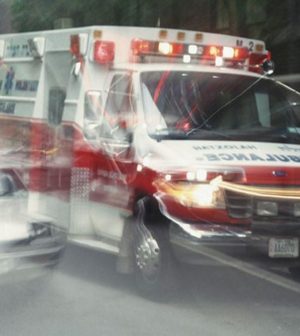- Navigating Your Midlife Crisis: Embracing New Possibilities
- City Raccoons Showing Signs of Domestication
- Mapping the Exposome: Science Broadens Focus to Environmental Disease Triggers
- One Week Less on Social Media Linked to Better Mental Health
- Your Brain Changes in Stages as You Age, Study Finds
- Some Suicide Victims Show No Typical Warning Signs, Study Finds
- ByHeart Formula Faces Lawsuits After Babies Sickened With Botulism
- Switch to Vegan Diet Could Cut Your Greenhouse Gas Emissions in Half
- Regular Bedtime Does Wonders for Blood Pressure
- Dining Alone Could Mean Worse Nutrition for Seniors
Women Less Likely to Get Best Care for Deadly Form of Stroke

Women are less likely than men to get the most effective treatment for a serious type of stroke, new research shows.
Emergent large vessel occlusion (ELVO) is a type of ischemic stroke caused when blockages in large blood vessels cut off significant blood flow to the brain.
The most effective treatment to prevent long-term disabilities from this type of stroke is a minimally invasive procedure called thrombectomy, which uses catheters to reopen blocked arteries in the brain.
“Many of the women who suffer emergent large vessel occlusion ischemic strokes are not being routed to the appropriate setting where they can get the most effective treatment,” said study author Dr. Muhammad Tariq, a neurology resident at McGovern Medical School at University of Texas Health Science Center at Houston.
“These patients should be sent to comprehensive stroke centers, where the care team specializes in treating strokes and preventing further damage,” he said in a center news release.
Comprehensive stroke centers have the expertise to perform thrombectomies and other treatments not available in primary stroke centers, Tariq explained.
He and his colleagues analyzed data from 10 stroke centers to determine which ELVO patients were routed directly to comprehensive stroke centers to receive more intensive care.
Of the 490 patients who had an ELVO, 46% were women. While 9 out of 10 men were routed directly to comprehensive stroke centers, the rate for women was nearly 11% lower.
A study co-author noted that women who suffer other kinds of strokes have generally been identified to receive less stroke treatment.
“A potential explanation for this difference could include failure to recognize stroke symptoms, which delays women in seeking care,” said study co-author Youngran Kim, postdoctoral research fellow in neurology at McGovern Medical School.
“Additionally, women who suffer a stroke tend to be older and may be frailer,” Kim said in the release. “Studies also show that women are more likely to present with ‘nontraditional’ stroke symptoms, such as fatigue, weakness, disorientation and mental status change.”
Tariq said he hoped that the results will help providers understand the need to bridge the gender gap.
“There are already existing routing mechanisms to ensure that patients receive the best care for their chance at survival and recovery,” he said. “I hope we can open up the conversation to show that there are patients who should be getting this treatment, but are actually not getting the help quick enough.”
The findings were presented recently at the Society of NeuroInterventional Surgery’s annual meeting, in Toronto. Research presented at meetings is typically considered preliminary until published in a peer-reviewed journal.
More information
The American Stroke Association outlines types of stroke and treatments.
SOURCE: University of Texas Health Science Center at Houston, news release, July 29, 2021
Source: HealthDay
Copyright © 2025 HealthDay. All rights reserved.










